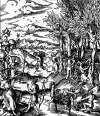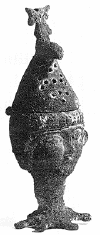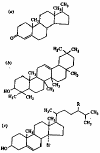|
Incense use is multifaceted and, to a large degree, a
potentially controversial topic. Incense is used in various
religious settings ranging from the far Eastern Hindu temples to
the Western Catholic churches and has often been depicted as a
"mood setter". It is also used in households as a freshener or as
a vehicle to add life or character to a setting. Thus, incense has
been known to carry an aura that is both compelling and, at times,
inexplicable. Understandably, incense use does not, therefore,
pass uncontested. My own personal reservations and questions are
as follows: Is incense simply just another generic smell? Could it
be more? Maybe a calming agent or a stimulant? And if either, what
physiological path does it take to alter our perception?
Initially, from self-observation, I was under the assumption
incense was nothing more than a calming agent. (In addition, one
should note, I meditate and undertake practices, such as yoga,
which require a great deal of focus or unwavering alertness.
Coupled with these practices it is also very common for me to
light a stick of incense to establish a suitable mood.) I assumed
incense was no more invigorating than a warm glass of milk. After
all, just like milk, incense relaxes me and unclutters the worries
of the day. However, when I presented sticks of incense to my
classmates, almost everyone seemed stimulated. People claimed the
mood was energetic and lively. Another Eastern student and I were
the only ones who actually felt calmed by the scents. I started to
question whether Easterners react peaceably simply out of
convention. In other words, maybe our perception was shaped by our
upbringing? Upon reflecting my lifestyle, this certainly presents
itself as a possibility. In my home, for instance, my family and I
utilize incense in our daily practices, and, also, the smell of
incense seems to bring back many pleasant memories of my childhood
and the recent past. My reaction, therefore, may have been
somewhat persuaded by outside influences. Furthermore, I presumed
the students who were not accustomed to the scents to be much more
objective than myself. Thus, based on my personal unreliability
and my class's Western objectivity, I hypothesized incense was
indeed a stimulant.
So the question remains, if incense is in fact a stimulant,
what proof is there? Sadly, much of smell research presents us
with very little hard evidence. This as well holds true for the
data and theories I will present. Hence, I cannot tangibly warrant
incense an undeniable stimulant, but, I can, nevertheless, cite
many semi-credible theories in support of incense's
stimulatory power. In other words, everything I will present
should be regarded simply as food for thought and nothing more.
INCENSE PRODUCTION
Only a small number of ingredients are incorporated into the
making of incense. Although the specific constituents vary
according to the type of incense, there are still quite a few
regularly used components. The most important components of
incense production are its resins. These include such substances
as myrrh, frankincense, galbanum, ladanum, and styrax. In
particular, myrrh and frankincense are the most commonly used.
So how exactly is a resin collected? Primarily, one should note
that myrrh and frankincense grow together in the same parts of
Arabia and Africa, and although the trees are husbanded
differently their precious products are collected in similar ways.
First of all a knife incision is made in the bark during the
middle of the summer (this is when the heat is at its most intense
stage). The incision must be deep enough to penetrate the
secondary cambium, where the secretary canals lie. The resin oozes
out onto the outside of the bark in pearl-like blisters where it
coagulates. Frankincense resin is yellow in color and myrrh resin
is reddish-brown. These resins are collected in August, before the
rains, by scraping the pearls from the trunks (Monod, 1979).

Another major component of incense is cassia and cinnamon which
are both barks. The above woodcut shows the bark of cassia (Cinnamomum
cassia) being stripped and transported to town. The main
source of cassia in the sixteenth century was the many islands in
the Straits of Molucca (Stoddart, 1990).
INCENSE USE AND ITS HISTORY
The earliest signs of incense use come from the ancient Chinese
who burned various herbs and plant products such as cassia,
cinnamon and sandalwood. The Hindus absorbed the cult of incense
from the ancient Chinese and introduced frankincense,
Sarsaparilla seeds and cyprus into the recipe. It was the
early Hindus who introduced the first trading routes to the West
and in particular to the incense lands of Arabia where only the
cherished frankincense grew. Furthermore, the Egyptians held that
the gods exuded a sweet odor and that safe passage to the
after-life could be assured if the cadaver was provided with
sufficient fragrance. Egyptians offered incense in a number of
other ways as well. Sometimes it was burned on a small,
cuboidal-shaped alter but more often it was offered in a hand-held
censer. A censer was usually accompanied with a lid which was
periodically lifted to release a cloud of smoke and thereupon an
inviting aroma.

The above picture is a censer from the Coptic period in Egypt (AD
284-641). It is in the shape of a young boy's head and dates from
about AD 400-500 (Stoddart, 1990).
From the Egyptians the Greeks also came into contact with
incense. Specifically, the Greeks used incense in the cult of
Aphrodite. It was believed that the goddess hid her nakedness with
myrtle when she first made landfall. The fragrance of myrtle has
even continued to play an important role in Greek incense
ceremonies to the present day. From the Greeks the Romans learned
of incense and, as is apparent, the rest is history!
INCENSE AND RELIGION
In religion incense is used primarily with the psychical
aspects of smell. It was thought that such perfumes would be
agreeable to the gods or spirits, on the same principle as that by
which foodstuffs which men like were offered to them.
In Egypt the burning of various kinds of incense was
always an important rite, each ingredient of it having magical
properties, and, as has been seen, its smoke was supposed to carry
the words of prayer as well as the souls of the dead to heaven.
The Greeks, on the other hand, simply felt the odours were
pleasing to the gods. In Roman religion incense was one of
the most important of the bloodless offerings, and without it no
rite was regarded as complete.
Incense was unknown in early Buddhism, which was opposed
to external ritual, but in the course of time its use, especially
in northern Buddhism has become general. Also, in Islamic
sects, incense is not commonly used, but it is regularly offered
at the shrines of saints, and is permitted by the traditions as a
perfume for a corpse. In addition, Christianity did not
seem to take much interest in incense in its early church rituals.
The fact that it was a Jewish custom may have tended to make
Christians neglect it, but what had probably a more powerful
effect was its use among pagans and the common practice during the
ages of persecution in which Christians were to offer a few grains
of incense to the gods or on the altar of the Emperor as a token
of their renunciation of their faith (MacCulloch,1914) (Rahim,
1987). However, as Takagai points out Matthew 2:11 states:
At the site of the star they were overjoyed. Entering the
house, they saw the child with Mary his mother, and bowed to the
ground in homage to him; then they opened their treasures and
offered him gifts: gold, frankincense, and myrrh.
Apparently, early Christians did not totally disregard incense
in the practice of their religion.
As mentioned earlier, my personal practices are very Eastern,
and, my beliefs are Hindu. I therefore went into great
detail in trying to understand Hindu incense use. I was greatly
supplemented in my knowledge by a personal interview with Dr. K.
L. Sheshagiri Rao, Chief Editor of the Encyclopedia of Hinduism
and Professor Emeritus at the University of Virginia. According to
Dr. Rao, there are five aspects to existence: earth, air, fire,
water and space. Of these five entities incense represents the air
aspect. Hindus feel that the integral nature of everything is
divine and that feelings of duality or separateness are caused by
ignorance. Similarly, incense use is integrally important in that
it is a symbol representing space. In addition, Dr. Rao claims
incense is supposed to have a calming effect on the mind. In
particular, jasmine and sandalwood scents are supposed to bring
out a peaceful mindset. He also claims that the scents should
cultivate a balance of the outer and inner atmosphere, thus
eliminating duality.
INCENSE: PHYSIOLOGICAL STIMULANT OR NOT?
Does incense possess some intrinsic property that allows it to
alter our minds? Or is it nothing more than some generic odor that
is perceived by the brain and colored as a mood alterer simply by
convention? As established by studies, good and bad smells
relative to the individual, can affect mood (Ehrlichman, 1994). So
what about incense? Is it necessarily the smell of incense that
affects us or is it something more? Could it possibly take some
sort of a physiological route to alter our minds? All these
questions and more must be answered in order to come to an
accurate conclusion.
As mentioned, there must be a route established through which
the smoke takes its affects. One possible route is through the
bloodstream in which the smoke may act somewhat like a narcotic.
The smoke residues could possibly enter through the lungs, travel
through the bloodstream, and then finally reach the brain. This
route, although possible, seems unlikely. After all, the smell of
incense generally produces an instantaneous reaction, and,
traveling through the bloodstream seems too drawn-out a process to
yield the spontaneity we are looking for. However, one should
note, if incense is inhaled at high enough concentrations, the
smoke can in fact produce an instantaneous reaction much like
second-hand smoke or opiates. Therefore, incense traveling as a
narcotic is a very plausible route and should not be disregarded
as a possibility.
So what are our other alternatives? How about neural activity!
In such a system the reaction could very nearly be instantaneous.
But how exactly are smell signals from the nose transmitted to the
brain? Well, to begin with, the initial detection of odors takes
place at the posterior of the nose, in the small region known as
the olfactory epithelium. Here, there are millions of neurons that
provide a direct physical connection between the external world
and the brain. From one end of each neuron, hairlike sensors
called cilia extend outward and are in direct contact with the
air. At the other end of the cell, a fiber known as an axon runs
into the brain. When an animal inhales odorous molecules, the
sensory neurons bind to specialized proteins, known as receptor
proteins, that extend from the cilia. The binding of odors to
these receptors initiates an electrical signal that travels along
the axons to the olfactory bulb, which is located in the front of
the brain, right behind the nose itself. The olfactory bulb serves
as the first relay station for processing olfactory information in
the brain; the bulb connects the nose with the olfactory cortex,
which then projects to higher sensory centers in the cerebral
cortex, the area of the brain that controls thoughts and behaviors
(Axel, 1995).
There are a number of potential scenarios for arranging neurons
and axons in the nose and brain. However, the most commonly
accepted theory goes as follows: neurons carrying one type of
receptor could be randomly positioned in the epithelium, but their
axons would converge on discrete areas in the brain. In this case,
exposure to a particular odor could result in defined patterns of
activity in the brain (Axel, 1995). If in fact the signal does
have a defined pattern of activity, the signal, caused by incense,
may initiate a pattern of neuronal activity that induces a certain
state of mind.
Please take note of the following diagram:

Here, all three molecules can elicit distinct responses, specific
to their receptors, based on their structural incongruities. One
should note, diagram (a) is an animal steroid, testosterone, and
(b) a resin, alcohol - amyrin - of the type found in incense, and
(c) a steroid found in myrrh. This is very interesting because (b)
and (c), both found in incense, have steroid-like structures,
similar to that found in testosterone (a). In addition, one should
keep in mind, pheromones are also known to have steroid-like
structures. This is important in that it leads us to a third
possibility or route for incense-related alteration
So if it elicits a similar response as a pheromone what does
that mean? Before we answer this let's get some background
knowledge. Most mammals, including humans, possess a vomeronasal
organ (VNO) that is physically separate from the main olfactory
epithelium. The vomeronasal organ detects the pheromones that
govern reproductive and social behaviors. Until recently, the VNO
in humans was thought to be a vestigial organ, but, biopsy reports
have shown the VNO to be a structurally intact organ. In addition,
one should note, it has been difficult to identify human
pheromones that elicit innate behavioral arrays since behavior in
humans is far more likely to be tempered by learning and
experience (Dulac & Axel, 1995). In other words, although a human
VNO may pick up pheromonal signals, it is still unclear how
significant the human VNO system is in modifying behavior.
Please remember some of the chemical components of incense have
similar steroidal structures as many mammalian pheromones. Thus,
incense could, in an indirect way, activate a pheromone-like
pathway sending its signals to the VNO. The implications behind
this are immeasurable. Could places of worship seem so appealing
simply because people are being altered to think this? Could
incense's chemical properties actually sexually arouse a person
into believing in a divine existence?
There are quite a few experiments in support of incense's
transforming power. Jellinek, for example, took ingredients from
incense which best resembled human body odour. He then developed
his study to inquire whether, since they have odours which
resemble those of the human body, incense ingredients are able to
enhance the erotic effect of light, floral eaux-de-Cologne. He
then took a panel of experienced perfumers to test the erogenic
properties of the various ingredients of incense. According to
these perfumers, all but one property of incense enhanced the
erogenic quality of the perfume. This study, though convincing, is
limited because the results cannot be quantified scientifically
(1965). Another experiment ran by Macht and Ting examined the
effect of odour of incense ingredients on the time taken by the
trained rats to circumnavigate a maze for a food pellet reward.
They state in their findings:
The lack of depression after the use of incense
is...surprising but agrees well with the statements of some
Orientals that the inhalation of the fumes of certain specimens of
incense are actually stimulating to the mental processes (Macht
and Ting, 1921).
"Surprising" does not even began to describe this multifaceted
concept called incense. Originally, I formulated a dichotomy,
which questioned whether incense did or did not have the intrinsic
ability to alter one's perceptions. And, if in fact it did, I came
up with several hypotheses reflecting incense's mode of action. In
summation, I believe there are three major possibilities through
which incense can distort one's mental processes: 1) as a
narcotic; 2) through neuronal patterns in the nose; and finally,
3) by mimicking pheromonal activity in the VNO. Although much of
what was said is purely theory (e.g. VNO, erogenic properties,
etc.), there is still room to question incense and its many faces.
Also, one should understand, incense-related modification may not
even be physiologically dependent. Therefore, one should not take
these theories as the undeniable truth. For all I know I could
just be "blowin' smoke."
www.sacred-magick.com
Powered By:
Soluzen
Hosting Solutions |